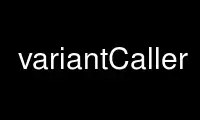
This is the command variantCaller that can be run in the OnWorks free hosting provider using one of our multiple free online workstations such as Ubuntu Online, Fedora Online, Windows online emulator or MAC OS online emulator
PROGRAM:
NAME
variantCaller - variant-calling algorithms for PacBio sequencing data
SYNOPSIS
variantCaller.py is invoked from the command line. For example, a simple invocation is:
variantCaller.py -j8 --algorithm=quiver \
-r lambdaNEB.fa \
-o variants.gff \
aligned_reads.cmp.h5
which requests that variant calling proceed, - using 8 worker processes, - employing the
quiver algorithm, - taking input from the file aligned_reads.cmp.h5, - using the FASTA
file lambdaNEB.fa as the reference, - and writing output to variants.gff (see pbgff(5)).
A particularly useful option is --referenceWindow/-w: this option allows the user to
direct the tool to perform variant calling exclusively on a window of the reference
genome, where the
OPTIONS
variantCaller.py --help
will provide a help message explaining all available options.
NOTES
Input and output
variantCaller.py requires two input files:
· A file of reference-aligned reads in PacBio's standard cmp.h5 format;
· A FASTA file that has been processed by ReferenceUploader.
The tool's output is formatted in the GFF format, as described in (how to link to other
file?). External tools can be used to convert the GFF file to a VCF or BED file---two
other standard interchange formats for variant calling.
NOTE:
Input cmp.h5 file requirements
variantCaller.py requires its input cmp.h5 file to be be sorted. An unsorted file can
be sorting using the tool cmpH5Sort.py.
The quiver(1) algorithm in variantCaller requires its input cmp.h5 file to have the
following pulse features:
System Message: ERROR/3 (doc/VariantCallerFunctionalSpecification.rst:, line 69)
Unexpected indentation.
· InsQV,
· SubsQV,
· DelQV,
· DelTag,
· MergeQV.
The plurality(1) algorithm can be run on cmp.h5 files that lack these features.
The input file is the main argument to variantCaller.py, while the output file is provided
as an argument to the -o flag. For example,
variantCaller.py aligned_reads.cmp.h5 -r lambda.fa -o variants.gff
will read input from aligned_reads.cmp.h5, using the reference lambda.fa, and send output
to the file variants.gff. The extension of the filename provided to the -o flag is
meaningful, as it determines the output file format. The file formats presently
supported, by extension, are
.gff GFFv3 format
.txt a simplified human readable format used primarily by the developers
If the -o flag is not provided, the default behavior is to output to a variants.gff in the
current directory.
NOTE:
variantCaller.py does not modify its input cmp.h5 file in any way. This is in contrast
to previous variant callers in use at PacBio, which would write a consensus dataset to
the input cmp.h5 file.
Available algorithms
At this time there are two algorithms available for variant calling: plurality and quiver.
Plurality is a simple and very fast procedure that merely tallies the most frequent read
base or bases found in alignment with each reference base, and reports deviations from the
reference as potential variants.
Quiver is a more complex procedure based on algorithms originally developed for CCS.
Quiver leverages the quality values (QVs) provided by upstream processing tools, which
provide insight into whether insertions/deletions/substitutions were deemed likely at a
given read position. Use of quiver requires the ConsensusCore library as well as trained
parameter set, which will be loaded from a standard location (TBD). Quiver can be thought
of as a QV-aware local-realignment procedure.
Both algorithms are expected to converge to zero errors (miscalled variants) as coverage
increases; however quiver should converge much faster (i.e., fewer errors at low
coverage), and should provide greater variant detection power at a given error level.
Confidence values
Both quiver and plurality make a confidence metric available for every position of the
consensus sequence. The confidence should be interpreted as a phred-transformed posterior
probability that the consensus call is incorrect; i.e.
QV = -10 \log_{10}(p_{err})
variantCaller.py clips reported QV values at 93---larger values cannot be encoded in a
standard FASTQ file.
Chemistry specificity
The Quiver algorithm parameters are trained per-chemistry. SMRTanalysis software loads
metadata into the cmp.h5 to indicate the chemistry used per movie. Quiver sees this table
and automatically chooses the appropriate parameter set to use. This selection can be
overridden by a command line flag.
When multiple chemistries are represented in the reads in a cmp.h5, Quiver will model each
read appropriately using the parameter set for its chemistry, thus yielding optimal
results.
Performance Requirements
variantCaller.py performs variant calling in parallel using multiple processes. Work
splitting and inter-process communication are handled using the Python multiprocessing
module. Work can be split among an arbitrary number of processes (using the -j
command-line flag), but for best performance one should use no more worker processes than
there are CPUs in the host computer.
The running time of the plurality algorithm should not exceed the runtime of the BLASR
process that produced the cmp.h5. The running time of the quiver algorithm should not
exceed 4x the runtime of BLASR.
The amount of core memory (RAM) used among all the python processes launched by a
variantCaller.py run should not exceed the size of the uncompressed input .cmp.h5 file.
Use variantCaller online using onworks.net services
